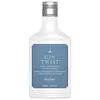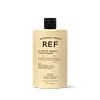What's inside
What's inside
 Key Ingredients
Key Ingredients

 Benefits
Benefits

 Concerns
Concerns

 Ingredients Side-by-side
Ingredients Side-by-side

Water
Skin ConditioningCetearyl Alcohol
EmollientHydrogenated Ethylhexyl Olivate
EmollientGlycerin
HumectantPropanediol
SolventCaprylic/Capric Triglyceride
MaskingQuaternium-91
Brassica Campestris Seed Oil
Skin ConditioningCocos Nucifera Oil
MaskingLinum Usitatissimum Seed Oil
PerfumingMangifera Indica Seed Butter
Skin ConditioningPanthenol
Skin ConditioningEmblica Officinalis Fruit Extract
Skin ConditioningBehentrimonium Chloride
PreservativeButyl Methoxydibenzoylmethane
UV AbsorberC11-15 Pareth-7
EmulsifyingCetrimonium Chloride
AntimicrobialChlorphenesin
AntimicrobialCitric Acid
BufferingDimethicone
EmollientDimethiconol
EmollientDisodium EDTA
Ethylhexyl Salicylate
UV AbsorberEthylhexyl Methoxycinnamate
UV AbsorberParfum
MaskingGuar Hydroxypropyltrimonium Chloride
Skin ConditioningHydrogenated Olive Oil Unsaponifiables
EmollientJojoba Esters
EmollientLaureth-9
EmulsifyingAmodimethicone
Myristyl Myristate
EmollientPolyquaternium-37
Trideceth-12
EmulsifyingEthylhexylglycerin
Skin ConditioningPhenoxyethanol
PreservativeTocopherol
AntioxidantBHT
AntioxidantLinalool
PerfumingHexyl Cinnamal
PerfumingBenzyl Salicylate
PerfumingWater, Cetearyl Alcohol, Hydrogenated Ethylhexyl Olivate, Glycerin, Propanediol, Caprylic/Capric Triglyceride, Quaternium-91, Brassica Campestris Seed Oil, Cocos Nucifera Oil, Linum Usitatissimum Seed Oil, Mangifera Indica Seed Butter, Panthenol, Emblica Officinalis Fruit Extract, Behentrimonium Chloride, Butyl Methoxydibenzoylmethane, C11-15 Pareth-7, Cetrimonium Chloride, Chlorphenesin, Citric Acid, Dimethicone, Dimethiconol, Disodium EDTA, Ethylhexyl Salicylate, Ethylhexyl Methoxycinnamate, Parfum, Guar Hydroxypropyltrimonium Chloride, Hydrogenated Olive Oil Unsaponifiables, Jojoba Esters, Laureth-9, Amodimethicone, Myristyl Myristate, Polyquaternium-37, Trideceth-12, Ethylhexylglycerin, Phenoxyethanol, Tocopherol, BHT, Linalool, Hexyl Cinnamal, Benzyl Salicylate
Water
Skin ConditioningCetearyl Alcohol
EmollientBehentrimonium Chloride
PreservativeCetrimonium Chloride
AntimicrobialAmodimethicone
Cetyl Esters
EmollientPhenoxyethanol
PreservativeCaprylic/Capric Triglyceride
MaskingLinum Usitatissimum Seed Oil
PerfumingParfum
MaskingPanthenol
Skin ConditioningAstrocaryum Murumuru Seed Butter
EmollientCitric Acid
BufferingEthylhexylglycerin
Skin ConditioningQuaternium-95
UV AbsorberArginine
MaskingTocopherol
AntioxidantButylene Glycol
HumectantGlycerin
HumectantLimonene
PerfumingPropanediol
SolventHexyl Cinnamal
PerfumingHelianthus Annuus Seed Extract
Skin ConditioningHydrolyzed Quinoa
Skin ConditioningBHT
AntioxidantPEG-8
HumectantHydrolyzed Vegetable Protein Pg-Propyl Silanetriol
Skin ConditioningCitral
PerfumingLinalool
PerfumingPEG-8/Smdi Copolymer
Palmitoyl Myristyl Serinate
Skin ConditioningSodium Polyacrylate
AbsorbentWater, Cetearyl Alcohol, Behentrimonium Chloride, Cetrimonium Chloride, Amodimethicone, Cetyl Esters, Phenoxyethanol, Caprylic/Capric Triglyceride, Linum Usitatissimum Seed Oil, Parfum, Panthenol, Astrocaryum Murumuru Seed Butter, Citric Acid, Ethylhexylglycerin, Quaternium-95, Arginine, Tocopherol, Butylene Glycol, Glycerin, Limonene, Propanediol, Hexyl Cinnamal, Helianthus Annuus Seed Extract, Hydrolyzed Quinoa, BHT, PEG-8, Hydrolyzed Vegetable Protein Pg-Propyl Silanetriol, Citral, Linalool, PEG-8/Smdi Copolymer, Palmitoyl Myristyl Serinate, Sodium Polyacrylate
Ingredients Explained
These ingredients are found in both products.
Ingredients higher up in an ingredient list are typically present in a larger amount.
This water-soluble silicone is used for its hydrating and softening properties. It is used to add a silky feel to skincare products and has great benefits for haircare.
In haircare, this ingredient:
- Adds shine
- Protects color
- Offers thermal protection
- Boosts hair strength
- Does not build up as easily
This ingredient is a preservative and often used for it's anti-static properties. You'll most likely see this ingredient in hair conditioners.
It does not cause irritation or sensitization in leave-on products at 1-5%.
BHT is a synthetic antioxidant and preservative.
As an antioxidant, it helps your body fight off free-radicals. Free-radicals are molecules that may damage your skin cells.
As a preservative, it is used to stabilize products and prevent them from degrading. Specifically, BHT prevents degradation from oxidation.
The concerns related to BHT come from oral studies; this ingredient is currently allowed for use by both the FDA and EU.
However, it was recently restricted for use in the UK as of April 2024.
Learn more about BHTThis ingredient is an emollient, solvent, and texture enhancer. It is considered a skin-softener by helping the skin prevent moisture loss.
It helps thicken a product's formula and makes it easier to spread by dissolving clumping compounds.
Caprylic Triglyceride is made by combining glycerin with coconut oil, forming a clear liquid.
While there is an assumption Caprylic Triglyceride can clog pores due to it being derived from coconut oil, there is no research supporting this.
Learn more about Caprylic/Capric TriglycerideCetearyl alcohol is a mixture of two fatty alcohols: cetyl alcohol and stearyl alcohol. It is mainly used as an emulsifier. Emulsifiers help prevent the separation of oils and products. Due to its composition, it can also be used to thicken a product or help create foam.
Cetearyl alcohol is an emollient. Emollients help soothe and hydrate the skin by trapping moisture.
Studies show Cetearyl alcohol is non-toxic and non-irritating. The FDA allows products labeled "alcohol-free" to have fatty alcohols.
This ingredient is usually derived from plant oils such as palm, vegetable, or coconut oils. There is debate on whether this ingredient will cause acne.
Due to the fatty acid base, this ingredient may not be Malassezia folliculitis safe.
Learn more about Cetearyl AlcoholThis ingredient is a preservative, antimicrobial, and emulsifier. It is often used in cosmetics for its ability to cleanse, condition, and reduce static.
Cetrimonium chloride is a quaternary ammonium salt, meaning it has a water-soluble structure.
Citric Acid is an alpha hydroxy acid (AHA) naturally found in citrus fruits like oranges, lemons, and limes.
Like other AHAs, citric acid can exfoliate skin by breaking down the bonds that hold dead skin cells together. This helps reveal smoother and brighter skin underneath.
However, this exfoliating effect only happens at high concentrations (20%) which can be hard to find in cosmetic products.
Due to this, citric acid is usually included in small amounts as a pH adjuster. This helps keep products slightly more acidic and compatible with skin's natural pH.
In skincare formulas, citric acid can:
While it can provide some skin benefits, research shows lactic acid and glycolic acid are generally more effective and less irritating exfoliants.
Most citric acid used in skincare today is made by fermenting sugars (usually from molasses). This synthetic version is identical to the natural citrus form but easier to stabilize and use in formulations.
Read more about some other popular AHA's here:
Learn more about Citric AcidEthylhexylglycerin (we can't pronounce this either) is commonly used as a preservative and skin softener. It is derived from glyceryl.
You might see Ethylhexylglycerin often paired with other preservatives such as phenoxyethanol. Ethylhexylglycerin has been found to increase the effectiveness of these other preservatives.
Glycerin is already naturally found in your skin. It helps moisturize and protect your skin.
A study from 2016 found glycerin to be more effective as a humectant than AHAs and hyaluronic acid.
As a humectant, it helps the skin stay hydrated by pulling moisture to your skin. The low molecular weight of glycerin allows it to pull moisture into the deeper layers of your skin.
Hydrated skin improves your skin barrier; Your skin barrier helps protect against irritants and bacteria.
Glycerin has also been found to have antimicrobial and antiviral properties. Due to these properties, glycerin is often used in wound and burn treatments.
In cosmetics, glycerin is usually derived from plants such as soybean or palm. However, it can also be sourced from animals, such as tallow or animal fat.
This ingredient is organic, colorless, odorless, and non-toxic.
Glycerin is the name for this ingredient in American English. British English uses Glycerol/Glycerine.
Learn more about GlycerinHexyl Cinnamal is a fragrance ingredient with a similar scent to jasmine. It can be naturally found in chamomile essential oil.
This ingredient is a known EU allergen and may sensitize the skin. The EU requires this ingredient to be listed separately on an ingredients list.
Hexyl Cinnamal is not water soluble but is soluble in oils.
Learn more about Hexyl CinnamalLinalool is a fragrance and helps add scent to products. It's derived from common plants such as cinnamon, mint, citrus, and lavender.
Like Limonene, this ingredient oxidizes when exposed to air. Oxidized linalool can cause allergies and skin sensitivity.
This ingredient has a scent that is floral, spicy tropical, and citrus-like.
Learn more about LinaloolLinum Usitatissimum Seed Oil is the expressed oil from the dried ripe seed of the Linseed, Linum usitatissimum L., Linaceae
Panthenol is a common ingredient that helps hydrate and soothe the skin. It is found naturally in our skin and hair.
There are two forms of panthenol: D and L.
D-panthenol is also known as dexpanthenol. Most cosmetics use dexpanthenol or a mixture of D and L-panthenol.
Panthenol is famous due to its ability to go deeper into the skin's layers. Using this ingredient has numerous pros (and no cons):
Like hyaluronic acid, panthenol is a humectant. Humectants are able to bind and hold large amounts of water to keep skin hydrated.
This ingredient works well for wound healing. It works by increasing tissue in the wound and helps close open wounds.
Once oxidized, panthenol converts to pantothenic acid. Panthothenic acid is found in all living cells.
This ingredient is also referred to as pro-vitamin B5.
Learn more about PanthenolParfum is a catch-all term for an ingredient or more that is used to give a scent to products.
Also called "fragrance", this ingredient can be a blend of hundreds of chemicals or plant oils. This means every product with "fragrance" or "parfum" in the ingredients list is a different mixture.
For instance, Habanolide is a proprietary trade name for a specific aroma chemical. When used as a fragrance ingredient in cosmetics, most aroma chemicals fall under the broad labeling category of “FRAGRANCE” or “PARFUM” according to EU and US regulations.
The term 'parfum' or 'fragrance' is not regulated in many countries. In many cases, it is up to the brand to define this term.
For instance, many brands choose to label themselves as "fragrance-free" because they are not using synthetic fragrances. However, their products may still contain ingredients such as essential oils that are considered a fragrance by INCI standards.
One example is Calendula flower extract. Calendula is an essential oil that still imparts a scent or 'fragrance'.
Depending on the blend, the ingredients in the mixture can cause allergies and sensitivities on the skin. Some ingredients that are known EU allergens include linalool and citronellol.
Parfum can also be used to mask or cover an unpleasant scent.
The bottom line is: not all fragrances/parfum/ingredients are created equally. If you are worried about fragrances, we recommend taking a closer look at an ingredient. And of course, we always recommend speaking with a professional.
Learn more about ParfumPhenoxyethanol is a preservative that has germicide, antimicrobial, and aromatic properties. Studies show that phenoxyethanol can prevent microbial growth. By itself, it has a scent that is similar to that of a rose.
It's often used in formulations along with Caprylyl Glycol to preserve the shelf life of products.
Propanediol is an all-star ingredient. It softens, hydrates, and smooths the skin.
It’s often used to:
Propanediol is not likely to cause sensitivity and considered safe to use. It is derived from corn or petroleum with a clear color and no scent.
Learn more about PropanediolTocopherol (also known as Vitamin E) is a common antioxidant used to help protect the skin from free-radicals and strengthen the skin barrier. It's also fat soluble - this means our skin is great at absorbing it.
Vitamin E also helps keep your natural skin lipids healthy. Your lipid skin barrier naturally consists of lipids, ceramides, and fatty acids. Vitamin E offers extra protection for your skin’s lipid barrier, keeping your skin healthy and nourished.
Another benefit is a bit of UV protection. Vitamin E helps reduce the damage caused by UVB rays. (It should not replace your sunscreen). Combining it with Vitamin C can decrease sunburned cells and hyperpigmentation after UV exposure.
You might have noticed Vitamin E + C often paired together. This is because it is great at stabilizing Vitamin C. Using the two together helps increase the effectiveness of both ingredients.
There are often claims that Vitamin E can reduce/prevent scarring, but these claims haven't been confirmed by scientific research.
Learn more about TocopherolWater. It's the most common cosmetic ingredient of all. You'll usually see it at the top of ingredient lists, meaning that it makes up the largest part of the product.
So why is it so popular? Water most often acts as a solvent - this means that it helps dissolve other ingredients into the formulation.
You'll also recognize water as that liquid we all need to stay alive. If you see this, drink a glass of water. Stay hydrated!
Learn more about Water